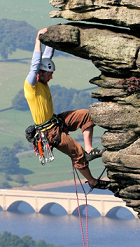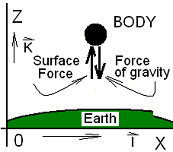| THERMO Spoken Here! ~ J. Pohl © | TOC NEXT ~ 123 |
Rock Climb
 A rock climber (50 kilograms) climbs down from the summit of a popular beginner-level formation (the competition is timed, "up and back.") The summit elevation is "H" meters greater than its bottom.
A rock climber (50 kilograms) climbs down from the summit of a popular beginner-level formation (the competition is timed, "up and back.") The summit elevation is "H" meters greater than its bottom.
i) Is there work?
ii) Calculate the work of the climber.
♦ i) Newton's 2nd Law relates the instantaneous change of momentum of a BODY with forces that act on it:

| (1x) |
The superscript identifies the space of the event as an 0XZ-plane. The summation of forces (right-of-equality) reminds us to add All forces relevant to the event. Usually there is more than one force.

The sketch at the right representing the man (approximated as a BODY) is exaggerated in size to permit the forces to be shown. Newton postulated two classes of force. Those that act upon the body "at a distance" (which we call "BODY forces") and others that act directly upon the BODY, (which we call "surface forces).
We rewrite the sum of forces of equation (2) as a single force of gravity (acting downward, labeled "force of gravity") and the sum of all other forces of contact with surroundings (assumed acting upward) which we label as "Surface Forces."
The sketch depicts the man at some "arbitrary location" during his climb. The actual climb occurs quite slowly and the longer it takes the smaller is the term left-of-equality in Equation (2). Mathematical expressions for Newton's 2nd Law and a displacement are written below.

| (3x) |
Work is the scalar product of a force times its displacement. With the model "BODY (mass at a point)," the mass and all associated forces have the same, identical displacement. Consequently multiplication of the entirety of Equation (3) by the displacement (above right) is physically valid. That operation (written symbolically) is:

| (4x) |
To procede, write the forces in magnitude-direction form, write the displacement in terms of its X and Z components and rewrite the equation:

| (5) |
Complete the right-side vector products to simplify:

| (6 = 4c2=6) |
Terms right-of-equality represent differential work. Some vector algebra and calculus is required to reduce the vector product left-of-equality. These steps are shown elsewhere. The results (change occurs with the left-of-equality term only) are:

| (7 = 4d) |
The term left-of-equality is the differential of a scalar property of the system (the man). This property (the first of energy related properties) is called kinetic energy, with the symbol KE.

| (8 = 4e) |
The steps above illustrate how differential mathematics is used to characterize physical change "at its basis." At its basis is the differential limit of no change at all. Reality involves change. Differential mathematics portrays reality when the differential equation is integrated between its limits. We apply the integration operator with limits to Equation (4e).

| (9 = 4f) |
Our next step is to write Equation (3) with the forces expressed in magnitude-direction form (below left). The gravity force has magnitude, mg, and its direction is downward, in the "-K" direction. The magnitude of the "force of support" is |F|, its direction id "K." Also written (below right) is a differential vector displacement of the climb.
Let's discuss this equation momentarily. Each term right-of-equality represents differential work, each term implies the potential of a force acting through its differential displacement consequent with an event of the BODY. The first term right-of-equality is known. It has a magnitude, "mass times gravity" and the direction of that force is downward, toward Earth. The unit vector, "minus K," quantifies the direction. The second differential of work is non-zero. That work occurs with the surroundings.
With a "climbing event" of finite displacement, upon integration ,that is, the differential terms of Equation (5) become finite. Simple limits of integration for an event are: z = z1 to z1 + H.

| (6) |
A brief discussion is in order. The "0" left-of-equality is physically significant. It means that the velocity of the man for the entire climb was zero. Thus our solution is not true or put otherwise, our solution more and more closely reflects truth as the time taken by the climber becomes greater and greater. Were the climb to require in a a year, the term left-of-equality
Newton's Rock Climb
 Consider a rock climber (50 kilograms) who climbs to the summit of a popular practice-level rock formation. The increase of elevation of the climber is 80 meters.
Consider a rock climber (50 kilograms) who climbs to the summit of a popular practice-level rock formation. The increase of elevation of the climber is 80 meters.
Typically, persons would view this task or event at one that involves work. In the common meaning of the word, it does involve "effort" or work. First apply Newton's 2nd Law, then apply the principles of thermodynamics.
Calculate the work of the climber.
Premise presently unwritted!